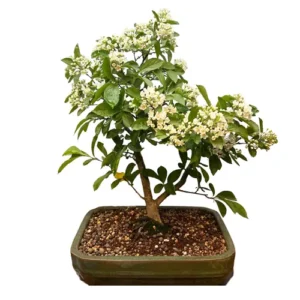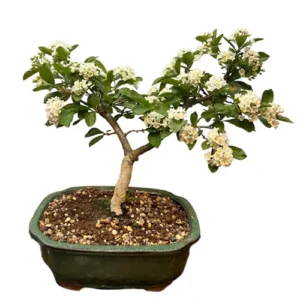Aesculus hippocastanum
Horse Chestnut Bonsai
Native to the Balkans, this deciduous bonsai can be grown from regular chestnut conkers. Aesculus hippocastanum is rare for bonsai due to its sizable palmate leaves that take some cultivation to scale for bonsai. White flowers in vertical clusters appear from the end of spring into the summer.
Horse Chestnut Bonsai Care Tips
Placement
Horse Chestnut demands plenty of sun. It should be placed in a position where it can receive approximately 6 hours or more of sunlight per day and needs protection from fierce winds. For prolonged periods of around 0 degrees C temperatures and below a frost free shed or greenhouse is advised.
Watering
Horse Chestnut bonsai is a specimen that loses a lot of water across its growth. They thrive when they are consistently moist, so water when the top inch of soil starts to feel dry. Across the growing season water consistently. During the winter watering can be slowed down.
Feeding & Fertilising
Be mindful of the feed used, too strong a fertiliser will cause the leaves to burn. Feed your Horse Chestnut bonsai with weaker feed solutions in the Spring. Balanced feeds and slow-release pellets are advised.
Pruning & Wiring
Horse Chestnut bonsai are predominantly shaped through pruning. During the growing season, pinch out new shoot tips once two or three leaves have appeared. Pruning the tips of buds before leaves emerge will encourage branch structure and maintain the plant’s silhouette.
Horse Chestnuts are best wired during the middle of the summer. Leave the wires on for only a single growing season. We recommend using wires with a thickness that matches the thickness of the branch: if the wire you choose is too thick you will damage the bark. If it is too thin, it won’t be effective.
Repotting
Repotting your tree is an important way to provide a fresh and suitable soil mix and ensure appropriate root health. Horse Chestnut require repotting in the Spring every three to five years. Avoid using too large a pot as this will cause the leaves to overgrow.
Trees that are ready for repotting will require root pruning, a suitable new pot and appropriate soil mix.
When repotting, do not cut back the root mass by a large amount, and choose a well-draining soil mix that has a neutral or slightly higher PH value of 5-6 but not over 7. We tend to use a mixture of different speciality bonsai soils on our trees. Every species is different so please contact us for free soil-mix advice or to take advantage of our repotting service.
Bonsai trees aren’t only magnificent additions to an indoor oasis, they are more than capable of standing out in any garden. Many Bonsai species are incredibly hardy and withstand nature’s colder and damper turns with aplomb making them worthwhile outdoor plants. We have an extensive library of care guides for outdoor bonsai trees. It’s not about selecting the perfect bonsai, it’s about selecting the perfect bonsai for you.
Horse Chestnut Bonsai - Typical Queries
Can you grow Horse Chestnut Bonsai from conkers?
You sure can! Using unharmed chestnut conkers and plating them in a seed box covered by soil is how to start. The soil needs keeping moist and the box needs to retain moisture so cover it with plastic. The box itself should be kept outdoors and the soil’s moisture needs maintaining. A long period of cold is required for growth to take place. Once two cotyledons appear some true leaves are soon to appear. When the true leaves are grown the plant can be taken from the seed box and potted in a bonsai-appropriate soil and pot.
Is Horse Chestnut bonsai suitable for beginners?
There are more straightforward bonsai for beginners to take on than the Horse Chestnut. Its care regime isn’t particularly complicated neither is it a delicate species, however, it does demand consistent pruning and a good outdoor spot with elemental protection. This can be taken on by beginners but it could also overwhelm them.
Do Horse Chestnut bonsai attract pests and diseases?
Horse Chestnut can suffer from fungal infections including canker, coral spot and leaf blotch. Leaf miners and scale are common intruders for this species. Correct insecticide can take care or pests and infected leaves should be removed along with any tainted wood.





















